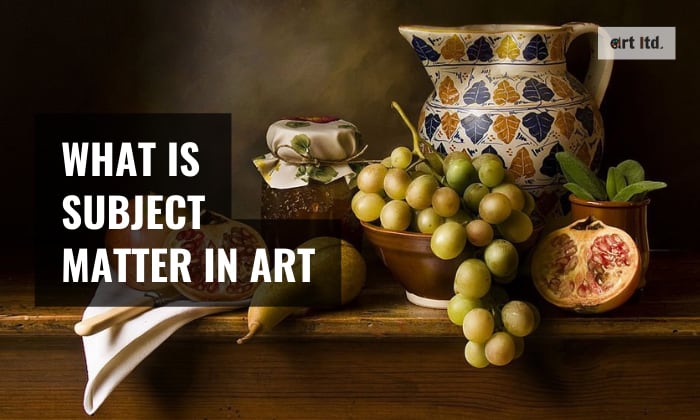Art covers a vast realm of different scopes and human interpretations. Regardless of its form, it should have at least one subject matter.
So, what is subject matter in art? It is mainly the subject and content or the focus in a work of art. Some artists prefer it loud and prominent, but for others, they’re sometimes hidden or vague.
In this article, we’ll dive deep into this context and learn its types, application, and explore different artworks.
Table of Contents
- What is Subject Matter in Art?
- Subject Matter in Art: Why is It Important?
- Types of Subject Matter in Art
- Use of Subject Matter in Different Art Forms
- Examples of Subject Matter in Famous Works of Art
- Tips to Choose the Subject Matter of an Artwork
- Interpretation of Subject Matter in Art
- Subject Matter in Contemporary Art
- Frequently Asked Questions
- Conclusion
What is Subject Matter in Art?
Aside from being the focal point, a subject matter in art could be a message that an artist wants to convey through an artwork.
A subject matter is one of the three basic components that comprise an artwork together with the artwork’s design and content.
They say every piece of art tells a story and each part is connected to a subject matter which can be a certain character, element, object, scenery, event, etc.
In short, the subject matter in art could be anything and everything an artist can think of.
Most of the time, it is evident and easily discerned, like the ones you see in representational art. For example, the sunflower in the famous still life art painting, the Vase with Fifteen Sunflowers by Van Gogh.
But sometimes you have to think twice to figure out the subject matter as they can be nonfigurative and more imaginative. Like the abstract painting by Cy Twombly and her personal interpretation of Greek mythology Leda and the Swan.
Subject Matter in Art: Why is It Important?
The importance of the subject matter in an art piece largely depends on the artist’s intentions. However, for artworks meant to be commercialized, choosing the right subject matter is crucial as it will be one of the major selling points.
Like any commercial item, art pieces for trade should attract certain audiences and somehow captivate a particular target market.
There is also a common advice for new artists that if they notice their art is no longer selling, maybe it’s time to reinvent and review their subject matter.
Types of Subject Matter in Art
1. Portraiture
Usually represents an image of a creature, mostly human. Highlighting or complementing its facial features but may also include the full body. It can be a solo portrait, a self-portrait, or a group portrait.
2. Still Life
Characterizes an organization of any inanimate objects or things that could either be natural or ornamental. Typically situated on a flat surface or a table. Some common examples are apples, flowers, wines, jars, and musical instruments.
3. Figurative
Involves everything that is tangible or an interpretation of the surrounding reality. It often touches some delicate areas such as sociopolitical matters, strong views, and opinions.
4. Abstract
Often conceptual, distorted, and does not depict a clear model or object. Created with a combination of different colors, shapes, and patterns. It can be curvilinear, colors or light manipulation, geometric, minimalist, emotional, or gestural.
5. Landscape
Celebrates and showcases the beauty of the untouched sceneries of the natural environment. Modern landscapes may also include views of urban cities and industrialization.
Use of Subject Matter in Different Art Forms
Other than paintings where the subject matter generates a general concept and defines its function, it is also made useful in theater arts, where the subject matter or the main character gets involved in different dramas to capture the audience’s interest.
In architecture, it serves as an inspiration to create aesthetically pleasing designs. However, the architects have to make sure it’s not only visually pleasing but also functional and practical.
Examples of Subject Matter in Famous Works of Art
1. The Mona Lisa
Artist: Leonardo da Vinci
Type: Portraiture
Subject Matter:
A woman named Lisa Del Giocondo. The title was derived from the word Mona which means madam and the first name of the subject.
2. Vanitas with Violin and Glass Ball
Artist: Pieter Claesz
Type: Still life
Subject Matter:
The violin, glass ball with the artist’s reflection, clock, skull, and other vanity objects implies that all of these are fleeting and death is imminent.
3. David
Artist: Michelangelo
Type: Figurative
Subject Matter:
The ideal features and full anatomy of a beautiful man in a counterpose.
4. Untitled
Artist: Wassily Kandinsky
Type: Abstract
Subject Matter:
The artist’s strong emotions. It’s profusely declared through vivid watercolors and ink.
5. Fuji Tagonoura
Artist: Shibata Zeshin
Type: Landscape
Subject Matter:
The majestic Mt. Fuji. Detailing the view of its mysterious and enchanting side when it starts to get dark.
Tips to Choose the Subject Matter of an Artwork
- 1. Define your audience and be aware of their demographics. It’s easier to pinpoint a relevant subject matter if you focus on a particular crowd.
- 2. Art is a form of self-expression. Find your passion and the subject matter you can relate to the most.
- 3. Look for inspiration and practice. Pick up some ideas and techniques that you can use in creating your own piece.
- 4. Build a storyline around your subject matter. Make it interesting.
Interpretation of Subject Matter in Art
The subject matters definition in art could again be very subjective. In art appreciation, a subject can mean everything in art but what you see or feel about a certain piece of art can sometimes be different from the artist’s intentions.
It can be professionally identified through Iconographic analysis. This process includes historical data and collective information or background of the author.
Another way to determine the subject matter is by contextual analysis. This is done by analyzing the cultural elements and historical context by answering predetermined questions that could break a complex context into smaller and digestible information.
Artwork can also be interpreted through visual analysis. However, this method is not inclined to understand the subject matter but more of the form.
These methods are mostly done to analyze what the subject means in art. Particularly significant artworks made in the past.
Moreover, a subject matter is often mentioned in the title, and if you have difficulties in identifying them, you can go back and refer to the title. It must be hidden there, somewhere.
Subject Matter in Contemporary Art
In this modern world, two of the pioneering contemporary art in art history are pop art and minimalism.
It breaks away from the typical and natural subject matter in the past. It is often regarded to lack emotions which is an essential source of subjects in art history.
These types of art focus on existing models and modern content that can be seen in magazines, commercials, and hints of industrialization. Apart from that, nature, feminism, and children are some of the most loved subjects of contemporary art.
In addition, contemporary art is no longer confined to doing paintings and sculptures, some of the modern approaches in contemporary art are:
- Kinetic Art
- Performance Art
- Video Art
- Graffiti Art
- Body Art
- Digital Art
Frequently Asked Questions
What is the difference between subject matter and content in art?
The subject matter is normally confused with the content. Here’s a short list of differences that can help differentiate them
|
Subject Matter |
Content |
|
A visual representation of concepts, ideas, or knowledge. |
The message that needs to be expressed using a subject matter |
|
Is The center of the artwork. |
Everything that is inside the artwork |
|
Is seen, observed, or analyzed. |
Is felt or sensed |
Can subject matter change over time in a single artwork?
Yes, some artists are entirely unpredictable and while working on a piece of art their intention and focus could shift at any point and so does the art’s subject matter
One solid example is the subject matter of a painting from Picasso’s controversial Les Demoiselles d’Avignon artwork below.
Apparently, the last one on the lower right is supposed to be a young man who is a medical student approaching the doors of the brothel.
Eventually, he came to some realizations and transformed that man into a woman which evidently changed the concept from a young man going into the brothel to 5 hookers in a brothel.
How does subject matter vary across different art forms?
The subject matter can vary across art forms in many ways. Paintings can have a subject matter relating to landscape, portraiture, or still life.
Literature can deal with different narratives relating to myths, legends, romance, mystery, fiction, and many more. Music on the other hand is more experiential. Mostly about love, loss, and betrayal.
Conclusion
What is subject matter in art? It is a powerful tool that enables artists to express their ideas, emotions, and views in any form of art.
Some strong subject matter can evoke or provoke different emotions and create dialogues to address important issues and challenging topics that are often avoided by the norms.
A subject matter serves as the foundation of artistic articulation that helps the new generation understand and find the meaning in art. Most of all, appreciate art, its rich history, and most of all, the artist behind it.

Art has always been a part of my life; it influences my upbringing and later my career choice. For me, it is always a part of my parenting technique. So for whichever purpose that you come to art, you can start here with us.














